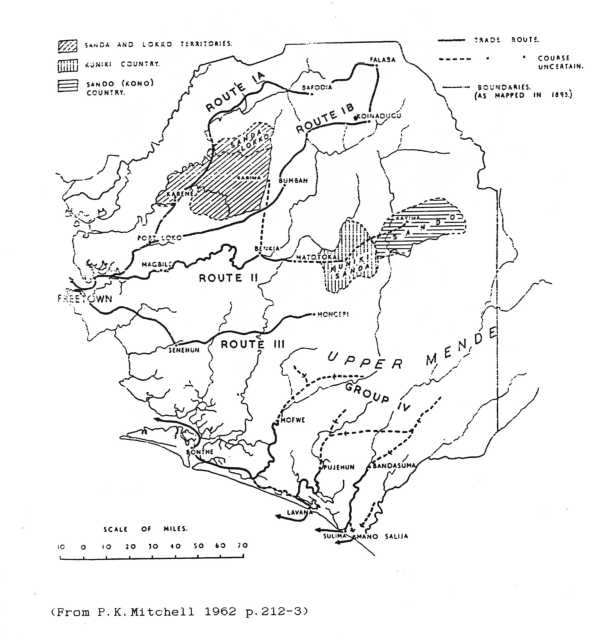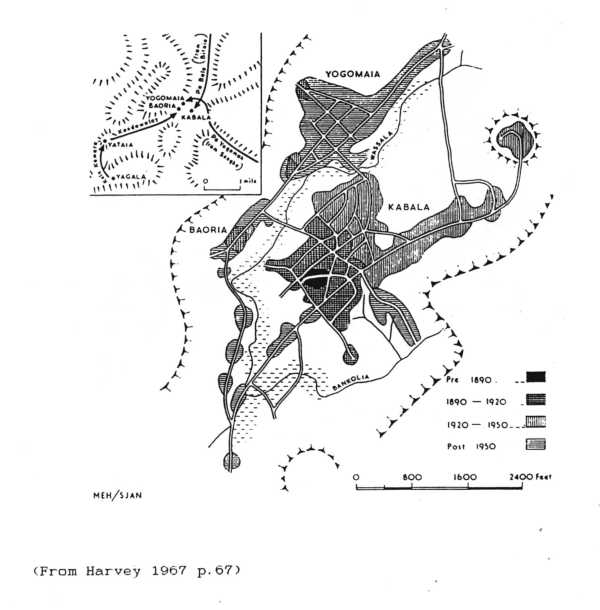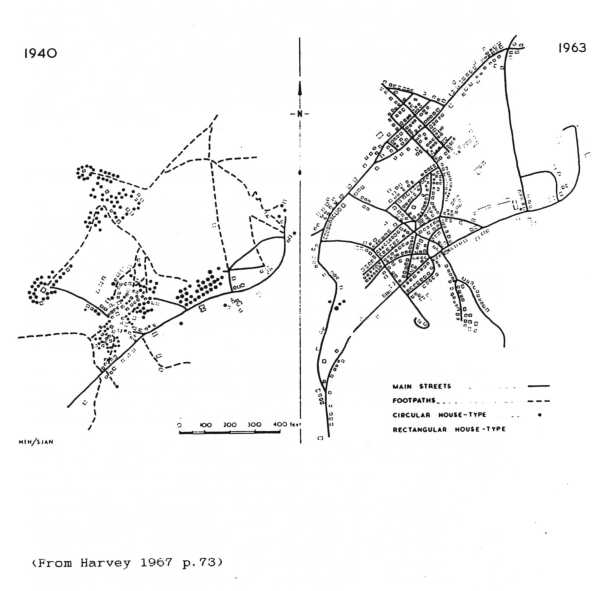 |
 |
| centres was hastened by the boundary delimitation agreements between the French and the British that were finalised
on 21st January 1895. Following the establishment of the colonial boundary between Guinea and Sierra Leone the
French were to divert the trade of the Niger Basin direct to Conakry. Without a prosperous hinterland Falaba, Musala, and Sinkunyia gradually declined. In 1896, shortly after the Anglo-Franco settlement, the colonial frontier post, formerly situated at Falaba, was transferred to Kabala. On the 1st December 1897 Kabala became the administrative headquarters of the Koinadugu district and has remained so to this day. Present day Kabala is, in fact, the result of a multicellular development based on three nuclei; Yogomaia, Gbauwria and Kabala. (map 1:3) The three settlements have now fused both morphologically and functionally, and the name 'Kabala' is presently used to mean all three settlements. However, this 'functional unity' applies chiefly to the administrative and commercial features of the town, for residential patterns, originally influenced by Kabala's multi-nodal development, continue to be in a variety of subtle ways. The founding of Gbauwria followed British requests to the chief of Warra Warra Yagala on whose land Kabala is situated, to send a representative to the town to act as "regent", responsible for the implementation of government laws. These requests were met and in 1909, in order to facilitate communication a new Limba settlement was founded by the chosen regent about half a mile from Kabala. Yogomaia was probably founded a few years earlier by a Koranko who, after quarrelling with his brother, the chief of Sengbe, had fled to the Warra Warra Yagala chief for protection. The chief allocated to him an area of land approximately half a mile north west of Kabala. The settlement became known as Yogomaia, meaning literally 'the place of Pa Yogoma'. (*8) By 1910 Gbauwria and Yogomaia were both permanent villages, although of the three only Kabala was sizeable. Including the barracks of the court messengers, as the frontier police were later to be known, Kabala consisted of 104 houses, with a population of 624 inhabitants. The town also had a resident district commissioner, a medical officer, and thirty court messengers, along with a market and twelve shops, reflecting its role as the new administrative, commercial, and medical centre for Koinadugu district. During the period 1920-1950 Yogomaia and Gbauwria experienced only a minimal increase in population, whilst Kabala continued to grow rapidly. In 1922 a road linking Kabala to Falaba was completed and eight years later the Makeni-Kabala motor road was opened. (*9) The improvement in road communications stimulated both commercial activity within Kabala and ensured a regular flow of trade through the town. At much the same time the colonial government's primary education programme resulted in an influx of children to the town from the surrounding rural areas. By 1929 Kabala, including the barracks, had a population of 1005. After 1930, continued extension of the government's administrative machinery stimulated further migration to the town, by providing much sought services as well as paid employment. Traders and merchants were attracted to the town, and by the end of the Second World War Kabala's commercial centre consisted of shops owned |
|
13 |
|
MAP 1:2 PATTERNS OF INTERNAL TRADE circa 1895 |
 |
|
KABALA: HISTORICAL DEVELOPMENT |
 |
|
MAP 1:4 |
|
KABALA: DISTRIBUTION OF HOUSES |
 |
| by Lebanese and Africans. In 1947 the total population of the three settlements had grown to 3064. Since the 1960s there has been little change in the direction of Kabala's growth and development. This is reflected in the modest rate of population growth, estimated for the years 1963-1974 at 4.4% per annum (*10) The modern story is one of continuity and consolidation. There has been expansion in some government departments, especially in education and rural development. This has brought further employment to the town. In the secondary and tertiary sectors, trade and commerce reflect Kabala's continuing importance as a distribution centre. Corresponding changes made in road transport have helped integrate this northern settlement more fully with the rest of the country. iv. Kabala today; a formal description and some impressions. (*11) The Central Business District occupies a central position. It is made up of a bustling daily market surrounded by the larger, one and two storey, Lebanese and African stores. (map 1:5) Nonetheless, a variety of commercial activities do take place outside the market area. Little change in the structure of the CBD has occurred since the 1960s, the biggest alteration being a marked increase in the number of large stores owned by Africans. In 1967 the only African shop which occupied a central location was a bar, still open today, situated close to the market. Since then many African traders have moved into premises vacated by the departing Lebanese. However, the Lebanese that remain still provide the core of the largest trading enterprises. Harvey noted in 1967 that specialisation in commerce was uncommon, and this is indeed still so today. The exceptions are found in the service sectors. Kabala has a photographic studio, two 'recording studios' (*12), several tailors, three petrol stations, a branch of Barclays bank, and so on. Most of the Lebanese shops and a few of the larger African stores are well stocked. The larger stores sell a variety of manufactured products, although supply fluctuates a great deal. The following list, although by no means exhaustive, gives some idea of the range of goods:- nails, biscuits, sweets, flour (by the sack), cement, custard powder, penicillin tablets, blankets, umbrellas, mirrors, motorbike tyres, tinned cheese, soft drinks (by the crate), sandals and shoes, school exercise books, electronic watches, rope, toilet paper, Marmite, cassette players, batteries, Nescafe, washing blue, Maggi stock cubes, hair gel, Zinc Pan, shotgun cartridges, Heinz salad cream, Ovaltine and Quaker oats. And so many things besides. Most of these items are imported, for example, the custard powder was Chinese, the tinned cheese from Holland, the Zinc Pan from Britain, the school exercise books from Guinea, the hair gel from Nigeria, etc., although the actual routes by which these goods reached Kabala were often obscure. Many of these imported articles are available in the smaller market stalls, the larger stores often being a link in the retailing chain selling in boxes and packets, items such as Chinese teabags, that smaller scale traders will then sell in smaller quantities to the final consumer. Cigarettes, for example, are commonly sold by the "stick". |
|
14 |